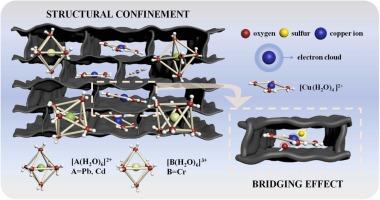低浓度Cu(II)的双重选择性吸附机理:结构约束和桥接效应
IF 11.3
1区 环境科学与生态学
Q1 ENGINEERING, ENVIRONMENTAL
引用次数: 0
摘要
本研究基于桥接效应理论,将硫引入到氧化石墨烯基气凝胶体系中,建立了氧-硫协同体系,实现了对低浓度Cu(II)具有狭缝结构和靶向结合位点的双机制选择性吸附。基于有机酸和表面活性剂化学性质的差异,对氧化石墨烯(GO)表面进行了官能化处理,实现了对其片层结构顺序的调控和碳缺陷的构建。在此基础上,将蒙脱土和氧化石墨烯的自积累与Ca(II)和海藻酸钠的交联机理相结合,制备了硫源改性氧化石墨烯基气凝胶,实现了对低浓度Cu(II)的选择性吸附。基于密度泛函理论,模拟了吸附Cu(II)前后材料表面自由基的形成过程,验证了加载Cu(II)后材料催化能力的有效提高。这意味着使用Cu(II)饱和吸附剂作为光催化剂来降解有机污染物,是一种有前途的危险废物再利用策略。上述研究为后续低浓度金属离子的去除及危险废物的潜在应用提供了新的研究思路。本文章由计算机程序翻译,如有差异,请以英文原文为准。

The dual selective adsorption mechanism on low-concentration Cu(II): Structural confinement and bridging effect
In this study, sulfur was introduced into the graphene oxide-based aerogel system based on the theory of bridging effect, and an oxygen-sulfur synergistic system was established to realize the dual-mechanism selective adsorption to low-concentration Cu(II) with slit structure and targeted binding sites. Based on the difference of chemical properties between organic acids and surfactants, the surface of graphene oxide (GO) was functionalized to realize the regulation of the order of its lamellar structure and the construction of carbon defects. On this basis, sulfur source modified GO-based aerogel was created to accomplish selective adsorption to low-concentration Cu(II) by combining the self-accumulation of montmorillonite and GO with the cross-linking mechanism of Ca(II) and sodium alginate. Based on the density functional theory, the formation process of radicals on the material's surface both prior to and following the adsorption to Cu(II) was simulated, and the effective improvement on the catalytic ability of the material after loading Cu(II) was verified. This means that using Cu(II) saturated adsorbent as a photocatalyst to degrade organic pollutants, is a promising reuse strategy for hazardous waste. The above research provides a new research idea for the subsequent removal of low-concentration metal ions and the potential application of hazardous wastes.
求助全文
通过发布文献求助,成功后即可免费获取论文全文。
去求助
来源期刊

Journal of Hazardous Materials
工程技术-工程:环境
CiteScore
25.40
自引率
5.90%
发文量
3059
审稿时长
58 days
期刊介绍:
The Journal of Hazardous Materials serves as a global platform for promoting cutting-edge research in the field of Environmental Science and Engineering. Our publication features a wide range of articles, including full-length research papers, review articles, and perspectives, with the aim of enhancing our understanding of the dangers and risks associated with various materials concerning public health and the environment. It is important to note that the term "environmental contaminants" refers specifically to substances that pose hazardous effects through contamination, while excluding those that do not have such impacts on the environment or human health. Moreover, we emphasize the distinction between wastes and hazardous materials in order to provide further clarity on the scope of the journal. We have a keen interest in exploring specific compounds and microbial agents that have adverse effects on the environment.
 求助内容:
求助内容: 应助结果提醒方式:
应助结果提醒方式:


